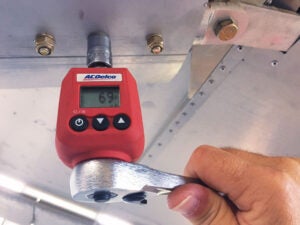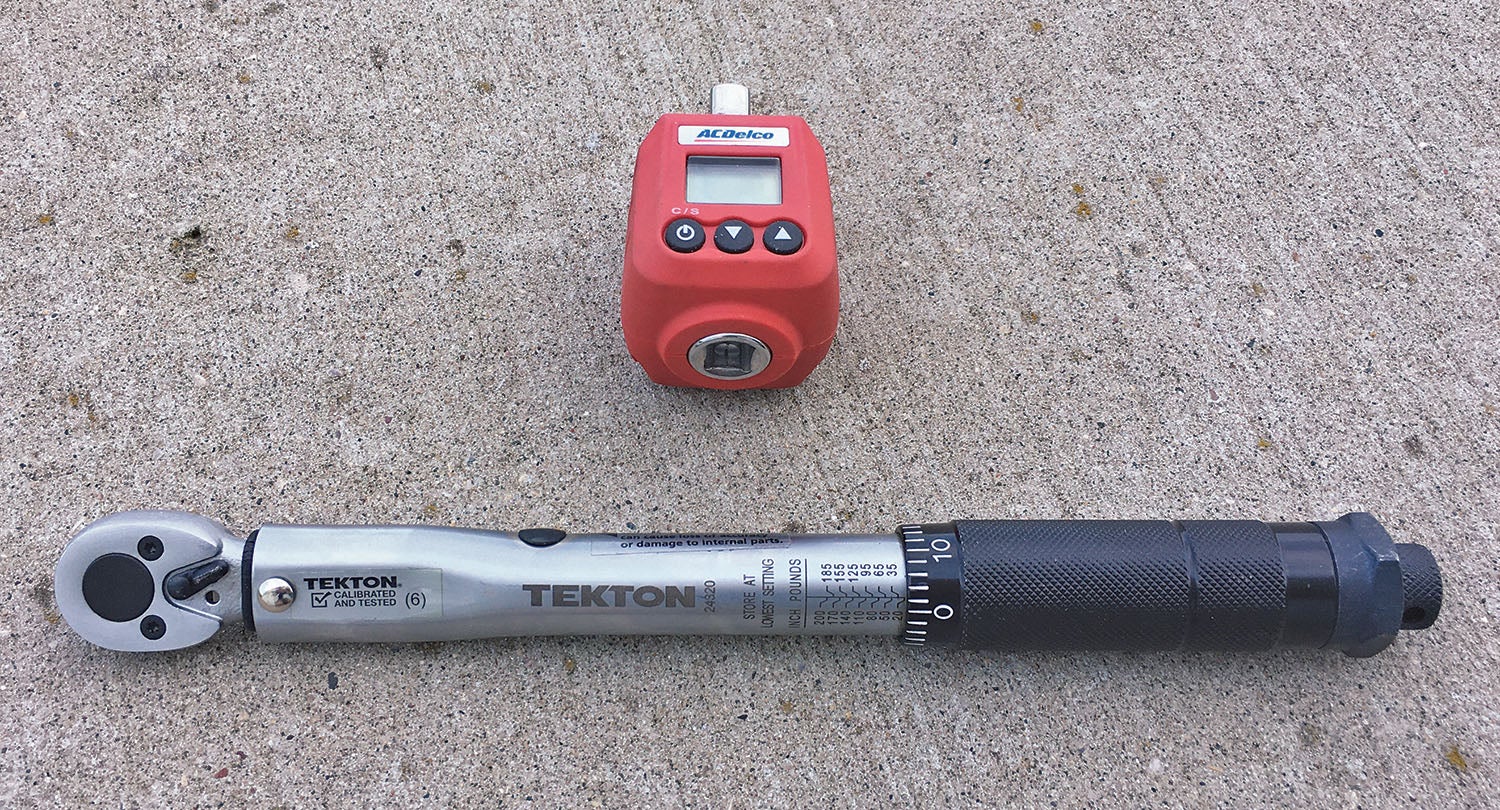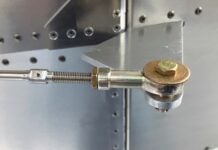
Every aircraft kit is designed with a number of nut and bolt fasteners that must be properly installed to complete the project. You may have wondered: Did I tighten that nut correctly? Did I make it tight enough—but hopefully not too tight? You are a conscientious builder if you have wondered about this subject. It does matter how much torque (twisting force) is applied to these fasteners.
There are a number of problems that can arise from either overtightening a fastener or leaving it too loose. Some of these problems are obvious—others not so obvious. Potential damage resulting from improper tightening is a great subject for another day. Let’s focus on achieving proper torque when installing this hardware. Tightening fasteners properly is a skill that should be learned and practiced.
One consideration for installing a nut is to know what the correct amount of torque is required. For a simple answer just look it up on a chart. Your kit manufacturer should provide this information in their documentation. If not, then ask Google for “aircraft torque values” to get some help (or use aircraft handbook AC 43.13-1B). You need to know the thread diameter and pitch of the fastener to make use of the chart. Let’s deal just with AN3 and AN4 tension type nuts and bolts for now as it is a good bet they make up the majority of the fasteners used in your kit.
An AN3 nut (with a 10-32 thread) gets 20–25 inch-pounds (equivalent to about 1.5–2 foot-pounds).
An AN4 nut (with a 1/4-28 thread) gets 50–70 inch-pounds (equivalent to about 4–6 foot-pounds).
So just what does it mean that an AN3 nut should be tightened to 20–25 inch-pounds? Simply stated, tighten that nut until the pressure you exert on your wrench handle at a location exactly 1 inch from the fastener is between 20–25 pounds. To visualize this you need a wrench handle with a mark at the 1-inch location. Then you need to be pressing at this mark (using a calibrated finger?) with a force of 20–25 pounds. Note there is a range of values here. It is not a critical amount as long as it is within range. (When using an AN310 elastic style lock nut, we need to add 5 inch pounds to the published values to compensate for the drag of the locking material of the AN3 size; add 15 inch pounds to the AN4 size).
Of course, we should use torque wrenches that make this tightening procedure easy and precise. Note the two styles shown. Both accomplish the same function but have a different method of reporting back the torque values obtained. The style with a handle substitutes for your wrench and provides a tactile “click” when the desired torque has been reached. The other style that fits between a conventional wrench and socket “beeps” and displays the numerical torque value. What is beneficial about using this kind of torque wrench is that you can silence the beep and simply tighten away on your nut until you “think” you have achieved the proper value—then peek at the readout. You may be surprised how far off you are! Both torque wrenches are relatively inexpensive and available almost anywhere tools are sold. (Yes, Amazon has a very large selection!)

A builder may ask whether a torque wrench should be used when tightening every fastener on their project. The purist will answer yes. In the real world this just does not seem to be the case. Here is an analogy: I remember my flight instructor years ago admonishing me to not stare at the panel while on final as I was learning to fly. I replied that I needed an accurate airspeed to control my landing. He asked me if the plane would fly with the airspeed indicator broken. I answered that if I came close to the proper speed by guessing, things should work out. He then made me understand that there was no guessing, but by way of practice I could accurately estimate airspeed by noting other cues of the aircraft (descent angle, etc).
This is the same for applying proper torque without a torque wrench. By way of practicing using a torque wrench, you can learn the feel of proper torque for a few of the most popular fastener sizes. The torque wrench with the readout is perfect for this. Simply test yourself with and without a torque wrench to see if you are making progress. At any time you feel this method doesn’t feel right—by all means use the torque wrench.
Here’s a challenge for even experienced builders. Clamp an AN3 bolt upside down in your vise and install a few washers and a nut (don’t let the nut bottom out on the bolt shank). Using a torque wrench that provides a display of the highest torque achieved (like the red one shown in the photo) attempt to properly tightened that AN3 nut without looking at the readout. When you are done—record your torque. Dollars to doughnuts you have probably really overtightened that little nut (25–30 inch-pounds with elastic locking material). Try this exercise with your builder friends. Then move on to larger nut sizes. You may be amazed how often we overstress the smallest of our fasteners!














So where can you buy a torque adapter or wrench that is accurate down to 25 inch pounds?. I can’t find one anywhere.
The 1/4″ drive torque wrenches are the ones to look for. Example: https://www.yardstore.com/cdi-torque-wrench-501mrmh-1-4-drive-size
The Torque adapters don’t go low enough for AN-3.
I searched high and low. Found the click wrench not clicking noticeable enough either.
BUT… there are Torque hex driver type wrenches that go down to 8 in/lbs.
I found this one at Home Depot. When the set torque is reached the handle disengages and freewheels.
About $60.00
https://www.homedepot.com/p/Husky-1-4-in-Hex-Inch-Torque-Screw-Driver-H4DTRQ/204772217?g_store=8438&source=shoppingads&locale=en-US&mtc=Shopping-B-F_D25T-G-D25T-25_1_HAND_TOOLS-Multi-NA-Feed-LIA-NA-NA-HandTools_LIA&cm_mmc=Shopping-B-F_D25T-G-D25T-25_1_HAND_TOOLS-Multi-NA-Feed-LIA-NA-NA-HandTools_LIA-71700000043839315-58700004592003384-92700049573927179&gclid=Cj0KCQjwufn8BRCwARIsAKzP6968khDDW9IYYWjiC_i-URpXJ-JOEL7EksTKbEMrmJNlM0RRCTrCnyYaAjJ2EALw_wcB&gclsrc=aw.ds